The Fighting Fourth
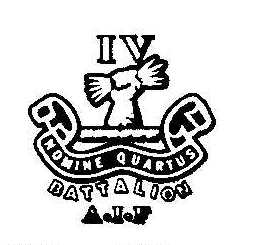
4th (Infantry) Battalion, Australian Imperial Force
Mass migration from Britain to Australia during the nineteenth and early twentieth century saw many west Walians make the epic three month voyage to the new country. A result of this migration was that many young men from Wales, and also the sons of these men, took up arms for Australia. One of Australia’s most renowned seamen was Commander Joseph Bathurst Beresford, who had been born in Laugharne in 1862. Beresford took command of the Australian Forces that fought against the various German colonies in the Pacific, especially during the now forgotten campaign in Papua New Guinea. Carmarthen man Major Dixon Hearder became one of the most well known Australian officers during the war, also being involved in politics in Australia. As far as can be ascertained, at least 418 Welshmen were killed while serving with the AIF, while at least 1,496 Welshmen served in the famous slouch hat. Countless more sons and daughters of Welsh migrants who were born in Australia would have served and died on top of these numbers.
With many ties to our cousins in Australia, this section of the website is dedicated to the memory of men who fell during the Great War with just one of the Australian infantry battalions, the one which my Great grandfather fought and died with: the 4th Battalion, Australian Imperial Force (AIF).
It was researching my Great Grandfather’s exploits during the war with the 4th Battalion, known among its numbers as the Fighting Fourth, which motivated me to embark on researching local war memorials. For this reason, this section of the website is dedicated to the men of this fine fighting unit, who fell in large numbers on the battlefields of Gallipoli and the Western Front.
After the outbreak of war in Europe, the colonial governments of Australia, Canada, India, New Zealand and South Africa, as well as our ancient ally, Portugal, pledged to support Britain in her fight against German oppression, and began mobilising their armed forces.
Throughout the states of Australia the call to arms began at once, and dozens of new battalions were formed to create an Australian Imperial Force. The city of Sydney was the centre point for the formation on 17 August 1914 of the 4th Infantry Battalion, which was raised at Randwick Racecourse, under the command of Lieutenant Colonel Astley John Onslow Thompson, VD. It may surprise many people to know that there was quite a strong tie to Wales with the 4th Battalion, Australian Imperial Force, or Fighting Fourth. The battalions original commander, Lieutenant Colonel Astley John Onslow Thompson, VD (pictured below), was a Carmarthenshire man, from the small mining town of Pontyates and, as well as my Great Grandfather, David Thomas John of Laugharne, at least twelve men of the battalion who fell during the course of the war were from Wales.
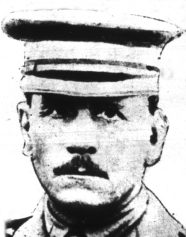
It is beyond the realms of this website to contain a full history of the Fighting Fourth following its formation, but each year of its existence has been broken down in diary form into notable events, which are published here. It is of note that during its existence, the battalion lost over 1,673 men dead, either killed, died of wounds or died of disease, while around 6,634 officers and men passed through its ranks. Compare that to a local battalion, such as the 15th Battalion, Welsh Regiment (Carmarthen Pals), who lost around 670 men dead, and it is plain to see that the Fighting Fourth fought through some tough campaigns, reinforcing Australian claims that they were used as elite troops, to attack the strongest enemy defensive positions.
1914
August 17th. Formation of 4th Australian Infantry Battalion at Randwick Racecourse.
August 22nd. 4th Bttn moved to tented camp at Kensington Racecourse.
August 29th. 4th Bttn moved to Randwick Racecourse.
Sept. 10th. Moved to tented camp at Barker Street, Randwick.
Sept. 20th. Moved to tented camp near Monastery, Kensington.
Oct. 19th. Embarked at Sydney on H.M.T.S. Euripides.
Oct. 20th. Sailed from Sydney Harbour.
Nov. 1st. Euripides left Albany.
Nov. 9th. H.M.A.S. Sydney engaged and sank German Cruiser ‘Emden’ at Cocos Island.
Dec. 3rd. Arrived in Alexandria.
Dec 4th-6th. Disembarked and entrained at Cairo. Camped near Mena House, Cairo.
1915
Jan. 1st. Adoption of 4 Company Organisation in 4th Battalion.
Feb. 7th. Arrival of 1st reinforcements to 4th Bttn.
April 3rd. Entrained at Cairo for Alexandria.
April 5th. Sailed at 1 a.m. from Alexandria in H.M.T.S. Lake Michigan.
April 8th. Arrived in Mudros Bay, on the Island of Lemnos.
April 24th. Left Mudros and anchored in a northern bay.
April 25th. Battalion arrived 4 a.m. with rest of fleet off Kaba Tepe, Gallipoli Peninsula. 8 a.m. to 12 noon-landing effected on beach North of Kaba Tepe. 4th Bttn reserve until 5 p.m. then advanced and dug in towards the right of Divisional front.
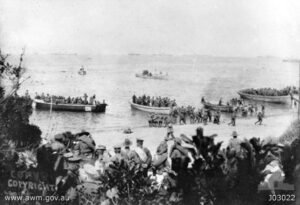
25 April 1915 – 4th Battalion Landing at Anzac beach
April 26th. General advance and subsequent withdrawal to original line. Lieutenant Colonel Astley John Onslow Thompson killed in action. Major Charles Melville MacNaghten wounded, and command devolved on Major D. Storey.
April 30th. 4th Bttn withdrawn to the beach and reorganised. Lieutenant Colonel A. J. Bennett D.S.O. assumed command. At night Bttn moved forward and took over trenches at head of Shrapnel Gully.
May 1st. Attempted Turkish advance checked and enemy dug in, in position known later as Johnston’s Jolly and Lonesome Pine.
May 2nd. 4th Bttn concentrated in held trenches with Division. ‘A’ Companies to South, and ‘B’ and ‘C’ Companies to South of Wire Gully.
May 18th. Transport section returned to Alexandria and disembarked.
May 19th. Strong Turkish attack repulsed with heavy loss to enemy.
May 20th. Turks attempted to arrange an impromptu armistice.
May 24th. Armistice.
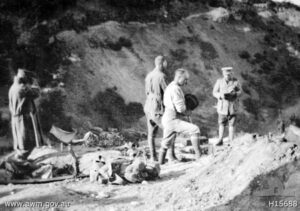
24 May 1915 – Padre McKenzie of the 4th Battalion, AIF, burying a soldier in Shrapnel Gully
June 12th. Battalion concentrated in trenches South of Wire Gully.
July 14th. Lieutenant Colonel A. J. Bennett D.S.O. transferred to 1st Battalion. Lieutenant Colonel C. M. MacNaghten assumed command of 4th Battalion.
August 6th. Attack and capture of Lonesome Pine trenches by 1st Brigade. 4th Bttn occupied left flank of Brigade, attacked with 3rd Battalion on immediate right. Battalion attacked on a two Company front, ‘A’ on right, ‘C’ on left, supported by ‘B’ and ‘D’.
August 9th. Relieved in Lonesome Pine Trenches by 7th Battalion.
Aug. 10th. Lieutenant Colonel C. M. MacNaghten evacuated, command assumed by Captain Alan Humphrey Scott.
Aug. 17th. 1st Anniversary of formation of 4th Battalion.
Sept. 13th. 4th Bttn left Gallipoli on H.M.T.S. Osmanieh, to train and refit in Lemnos.
Oct. 30th. 4th Bttn returned to Gallipoli from Lemnos on H.M.T.S. Osmanieh and occupied trenches at head of Clarke’s Gully in support.
Nov. 30th. Snowstorm.
Dec. 3rd. Lieutenant Colonel MacNaghten re-assumed command.
Dec. 19th. Evacuation of Anzac Cove position. 4th Bttn embarked in Echelons-‘A’, ‘B’ & ‘C’ on H.M.T.S. Simla.
Dec. 31st. Arrived Alexandria and proceeded to camp at Mustaphi, near Alexandria.
1916
Jan. 2nd. Battalion moved to camp at Tel-el-Kebir.
Feb. 10th. Formation of 4th & 5th Divisions began. 56th Bttn formed from 4th Bttn under command of Major Alan Humphrey Scott DSO. (Scott was later killed in Polygon Wood in 1917).
Mar. 1st. 4th Bttn entrained at Tel-el-Kebir and proceeded to camp East of Serapeum on Suez Canal.
Mar. 6th. Transfer of 4th Bttn Vickers Machine Gun Section to form section of 1st Australian Machine Gun Company.
Mar. 10th. Formation of 4th Bttn Lewis Gun Section with 4 guns.
Mar. 12th. Transfer of personnel to assist formation of 1st Australian Pioneer Battalion.
Mar. 18th. Advanced party from 1st Brigade left Serapeum for Alexandria under Captain Bertie Vandeleur Stacy.
Mar. 23rd. 4th Bttn left Alexandria on H.M.T.S. Simla.
Mar 29th. 4th Bttn arrived off Marseilles.
Mar. 30th. Battalion disembarked at Marseilles & entrained for Flanders. Transport Section remained at Marseilles.
April 2nd. Battalion detrained at Steenbeek and marched to billets at Staple.
April 8th. Major Ivan Gifford Mackay rejoined from 1st Brigade Advance Party and assumed command.
April 10th. Battalion marched from Staples to billets in Outtersteene.
April 12th. Transport Section rejoined Battalion by march route from Abbeville.
April 18th. Battalion marched from Outtersteene to billets in Sailly.
April 19th. Battalion relieved Manchester Regiment in support billets in Petillon sector.
April 25th. 1st Anniversary of landing in Gallipoli. Extra rations from regimental funds.
May 3rd. 4th Bttn relieved 2nd Bttn in front line. Petillon sector of trenches (Cordonnerie Farm).
May 20th. Battalion relieved by 11th Bttn and marched to billets in Sailly.
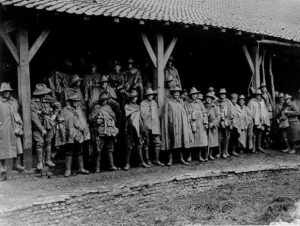
May 1916 – Men of the 1st Australian Division in billets – a nice cosy barn!
May 31st. Naval battle off Jutland.
June 4th. 4th Battalion sent five Officers & 243 men by march to Morbecque for 2 days musketry.
June 10th. 4th Bttn relieved 8th Bttn in Fleurbaix billets.
June 12th. H.M.S. Hampshire sunk, with Lord Kitchener and staff.
June 24th. 4th Bttn relieved 2nd Bttn in front line in Wye Farm sector.
June 28th. Cylinder Gas installed in 4th Bttn trenches & raiding party readied.
July 1st. Commencement of Battle of the Somme.
July 6th. 4th Bttn relieved by 46th Bttn and marched to billets in Sailly.
July 9th. Battalion marched from Sailly to billets in Outtersteene.
July 11th. Battalion marched to Bailleul, thence by train to Candas, thence marched to billets in St. Ouen.
July 12th. Battalion marched from St. Ouen to billets in Vignacourt.
July 13th. Battalion marched from Vignacourt to billets in Allonville.
July 15th. Officers of 1st Brigade visited recently captured trenches at Fricourt.
July 16th. Battalion marched from Allonville to billets in Warloy. Lewis Gun Section now has 6 guns.
July 19th. Battalion marched from Warloy via Albert to reserve trenches at La Boiselle in relief of 13th Royal Fusiliers.
July 22nd. Battalion moved forward to assembly positions before Pozieres in rear of 2nd Battalion on Brigade left.
July 23rd. Attack and capture of Pozieres by 1st Australian Division. Zero hour 12.30 a.m. ‘C’ & ‘D’ Companies pass through 2nd Battalion and capture 3rd objective. ‘A’ & ‘B’ Companies garrisoned old trenches.
July 24th. Relief of ‘C’ & ‘D’ Companies by ‘A’ & ‘B’ Companies.
July 25th. Battalion bombers & Lewis Gunners, supported by ‘A’ & ‘B’ Companies, advanced at 5 a.m. & captured Kay Trench as far as Cemetery.
July 27th. Relieved at 4 a.m. by 24th Battalion and marched to Brick Fields, Albert. In afternoon marched to camp in Vadencourt Wood.
July 28th. Battalion marched at close of day from Vadencourt Wood to La Vicogne Chateau and bivouacked.
July 29th. Battalion marched from La Vicogne to billets in Bonneville.
July 30th. Battalion marched from Bonneville to billets in Halloy-les-Pernois.
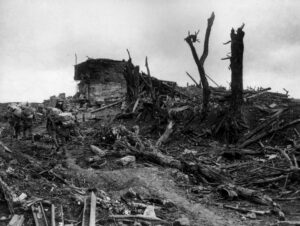
The famous Gibraltar Bunker guarding Pozières, facing the direction of Albert
August 5th. Sports and concert in Orchard at Halloy. Lewis Gun Section given total of 8 guns.
August 9th. Marched from Halloy to La Vicogne Chateau and bivouacked in garden.
August 10th. Marched from La Vicogne to billets in Herisart.
August 14th. Battalion marched from Herisart to camp in Vadencourt Wood.
August 15th. Battalion marched in morning from Vadencourt to bivouac on Western edge of Albert. In afternoon, under C.O., ‘A’ & ‘B’ Companies, half Lewis Gunners, bombers & signallers moved forward and relieved 50th Bttn before Mouquet Farm. At night, remainder of Battalion, under Senior Major, marched to Sausage Valley.
August 17th. Second Anniversary of formation of Battalion. ‘A’ Company of 3rd Battalion relieved ‘D’ Company of 4th Battalion, and 4th Battalion then sidestepped West and occupied Quarry, and patrols reached precincts of Mouquet Farm.

A view of the famous Mouquet Farm, north of the road from Courcelette
August 18th. ‘A’ Company advanced 100 yards at night and dug new trenches, beating off German attack. ‘D’ Company, 2nd Battalion attached to 4th Battalion. (The author’s great Grandfather, Lance Corporal David Thomas John (244), pictured below, killed during a patrol in the morning).
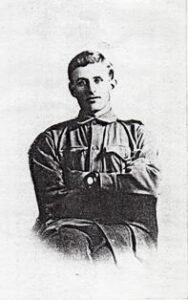
August 19th. ‘C’ & ‘D’ Companies relieved on right by 12th Battalion, and ‘A’ & ‘B’ Companies by 9th Battalion, and 4th Battalion then concentrated in billets at Albert.
August 21st. Battalion marched from Albert to billets in Warloy.
August 22nd. Battalion marched from Warloy to bivouac at La Vicogne Chateau.
August 24th. Battalion marched from La Vicogne to billets at Longuevillette.
August 25th. Sports at Longuevillette to commemorate 2nd Anniversary of formation of 4th Battalion on 17th August, 1914.
August 26th. Battalion marched from Longuevillette to Doullens, entrained there and detrained at Hopoutre, near Poperinghe. Marched to camp called Scottish Lines.
Sept. 1st. Battalion marched from Scottish Lines to Brandhoek, entrained there, detrained Ypres Asylum, marched to billets in Ypres.
Sept. 6th. 4th Battalion relieved 2nd Battalion in line near Mount Sorrel.
Sept. 13th. Battalion relieved in trenches by 19th Battalion and marched to Ypres, thence by train to Brandhoek and marched to Scottish Lines.
Sept. 26th. Battalion marched from Scottish Lines to Café Belge area and relieved 8th Battalion in support.
Sept. 29th. 4th Battalion HQ moved to Woodcote House.
Oct. 8th. Battalion relieved 2nd Battalion in front line-Verbrandenmolen Trenches.
Oct. 13th. Battalion relieved in trenches by 15th Battalion, marched to Ypres, thence trained to Brandhoek and marched to Scottish Lines.
Oct. 14th. Battalion marched from Scottish Lines to billets between Abeele and Steenvorde.
Oct. 15th. Battalion marched to billets in Noordpeene.
Oct. 16th. Battalion marched from Noordpeene to billets in Ganspette.
Oct. 19th/20th. Votes taken in 4th Battalion in connection with referendum on conscription in Australia.
Oct. 21st. Battalion marched from Ganspette to St. Omer, thence train to Longpre, thence marched to billets at L’Etoile.
Oct. 23rd. Battalion marched from L’Etoile to Mouflers, thence by bus to Buire, thence marched to tents and shelters near Fricourt.
Oct. 24th. Battalion marched to shelters East of Mametz Wood.
Oct. 29th. Battalion marched to Delville Wood and relieved 1st Royal Dublin Fusiliers in support position.
Nov. 1st. Battalion relieved 2nd Battalion in front line North of Flers and West of Grass Lane.
Nov. 2nd. Battalion received 2 additional Lewis Guns-total now 10 guns.
Nov. 6th. Battalion relieved in front line by 2nd Battalion, and marched to shelters in Delville Wood.
Nov. 13th. Battalion relieved in support by 52nd Battalion and marched to shelters in Bernafay Wood.
Nov. 14th. Battalion marched to Fricourt Camp-Nissen Huts.
Nov. 15th. Battalion marched to billets in Buire.
Nov. 17th. Battalion proceeded in buses from Buire to billets in Flesselles.
Dec. 1st. Battalion marched from Flesselles to Vignacourt, thence by train to Becourt thence marched to billets in Ribemont.
Dec. 6th. Battalion marched from Ribemont to Nissen huts at Mametz.
Dec. 19th. Battalion marched from Mametz C Camp to huts and shelters in Bernafay C Camp.
Dec. 20th. Battalion marched from Bernafay and relieved 5th Battalion in support position in Gap Trench and Switch Trench, South East of Flers.
Dec. 27th. Battalion Mining Platoon commenced tunnel dug-outs at Bulls Road.
Dec. 31st. Battalion relieved 3rd Bttn in front line North of Grass Lane and North East of Gueudecourt.
1917
Jan. 2nd. Battalion extended frontage in an easterly direction by taking over a Company front from 1st Battalion, including Goodwin’s Post.
Jan. 7th. Battalion relieved in front line by 48th Bttn and marched to Coolgardie Camp near Bazentin-le-Grand.
Jan. 8th. Battalion marched to Quarry Sidings, thence by train to Meaulte, thence marched to billets in Ribemont.
Jan. 13th. Battalion marched from Ribemont to billets in Contay.
Jan. 16th. Distribution of 4th Battalion match boxes dated ‘Aug. 17th 1914-Aug. 17th 1916.’
Jan. 22nd. 4th Bttn Brass Band formed.
Jan. 23rd. Battalion marched from Contay Camp to camp of Nissen huts near Becourt.
Jan. 27th. Battalion marched to Nissen hut camp in Brigade Reserve in Bazentin-le-Petit.
Jan. 31st. Battalion relieved 3rd Bttn in Brigade Support just South-East of Beaucourt-l’Abbaye.
Feb. 4th. Battalion relieved 2nd Bttn in front line North East of Beaucourt-l’Abbaye.
Feb. 10th. 4th Battalion raid on The Maze not successful.
Feb. 11th. Battalion relieved by 12th Bttn and marched to Nissen hut camp at Bazentin-le-Petit.
Feb. 12th. Battalion marched to Nissen hut camp at Fricourt Farm.
Feb. 21st. 4th Battalion Memorial Cross erected at Pozières.
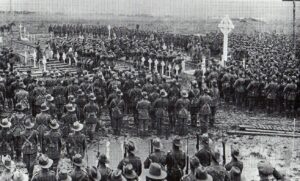
21 February 1917 – Men of the 4th Battalion attending the memorial service at Pozières.
Feb. 22nd. Battalion marched from Fricourt Camp (B) to billets in Albert.
Feb. 25th. Battalion marched from Albert to Bendigo Camp near Bazentin (Due to German withdrawal).
Feb. 27th. Battalion relieved 12th Bttn in front line at Le Barque. HQ in Wheat Trench.
Feb. 28th. Battalion advanced a further 600 yards North of Le Barque and established posts in Trap Trench & Trip Trench.
March 1st. Battalion moved Westwards by giving up part of front East to 3rd Bttn and taking over more on West from 17th Bttn.
March 2nd. Under cover of fog, Germans attacked Le-Barque and Ligny-Thilloy about 7 a.m. Attack on the whole 1st Brigade & 2nd Brigade front repelled.
March 5th. Battalion relieved by Companies of 21st & 22nd Battalions and marched to camp at Bazentit-le-Petit.
March 6th. Battalion marched to Fricourt Camp B.
March 23rd. Battalion marched to billets in Ribemont.
April 3rd. Battalion marched from Ribemont to camp of Nissen huts just West of Montauban.
April 4th. Battalion marched from Montauban to Fremicourt.
April 5th. Battalion marched to Velu and constructed shelters.
April 7th. Battalion dug assembly trenches just South West of Doignies.
April 9th. At 2 a.m. ‘A’ & ‘C’ Companies and Battalion HQ moved to assembly trenches near Doignies. ‘B’ & ‘D’ Companies to Brigade Reserve. 2nd Battalion and part of 3rd Battalion attacked and captured Hermies. 1st Battalion captured Demicourt. Canadians captured Vimy Ridge.
April 11th. Battalion relieved 1st Battalion in trenches South of Demicourt to North of Boursies.
April 13th. Battalion advanced about 1000 yards all along front and dug in.
April 15th. At 4 a.m. heavy enemy bombardment and attack launched on wide front. German attack on 1st Brigade front beaten off with heavy loss.
April 18th. Quarter Master Stores at Velu blown up by explosion of hidden German Mine.
April 21st. Battalion relieved in front line by 3rd Battalion and marched to Beaumetz in support.
April 24th. Battalion marched to billets in Bapaume.
April 25th. Second Anniversary of landing in Gallipoli.
April 26th. Received 21st Battalion in reserve near Vaulx.
April 27th. Battalion relieved by 21st Battalion near Vaulx and returned to billets in Bapaume.
April 28th. Battalion moved into support near Vaulx.
May 3rd. Attack on Bullecourt by 2nd Australian Division. 4th Battalion moved forward and relieved 17th Battalion in support near Bullecourt.
May 4th. Battalion supported 2nd Battalion in successful bombing attack, resulting in capture of several hundreds of trench.
May 5th. Battalion relieved by 11th Battalion and became support of 1st Brigade.
May 6th. ‘A’ & ‘C’ Companies ordered forward at 6.30 a.m. to repel German counter attack on Brigades to the right. Later 4th Battalion relieved 1st Battalion in O.G.1. trench.
May 7th. At 3.45 a.m. further successful attack on Bullecourt trenches and more ground gained on left. 4th Battalion relieved in O.G.1 by 5th Battalion and marched to Noreuil.
May 9th. Battalion marched from Noreuil to shelters in Bancourt.
May 15th. Battalion marched from Bancourt to camp near Bazentin-le-Petit.
May 22nd. Battalion marched from Bazentin to billets at Buire.
May 30th. Re-opening of 4th Battalion Sergeants Mess-first time since arrival in France.
June 1st. Adoption of Regimental March-‘Cupid in the Briny’.
June 2nd. 4th Battalion Athletic Sports and Horse Racing.
June 20th. 4th Battalion Bagpipe Band re-formed.
June 28th. Battalion marched from Buire to camp South West of Mailly Maillet.
June 30th. 1st Brigade Ceremonial Parade and Inspection by General Birdwood.
July 6th. Battalion marched from Mailly Maillet to billets in Buire.
July 13th. Battalion marched from Buire to camp near Bray.
July 24th. Battalion marched from Bray to billets in Buire.
July 27th. Battalion entrained at Edgehill, detrained at Bavincheve and marched to billets near Zuytpeene.
July 31st. Commencement of 3rd Battle of Ypres by successful Allied advance.
Aug. 9th. Battalion marched from Zuytpeene to billets neat La Motte.
Aug. 17th. Third Anniversary of formation of 4th Battalion Sports and Swimming Carnival in La Motte Canal. Concert in evening.
Sept. 13th. Battalion marched from La Motte to billets North of Meteren.
Sept. 14th. Battalion marched from Meteren to Cornwall Camp near Ouderdom.
Sept. 16th. Battalion marched from Cornwall Camp to camp just South West of Dickebusch.
Sept. 17th. A Platoon from each Company made shelters for supports between Zillebeke and Hooge.
Sept. 19th. Battalion marched from Dickebusch to camp North East of Café Belge.
Sept. 20th. At 5.40 a.m. 1st Australian Division took part in successful renewal of advance in Ypres battle. At 6.40 a.m. 4th Battalion marched from Café Belge to support shelters near Halfway House.
Sept. 21st. Battalion relieved 5th & 6th Battalions in support near Polygon Wood.
Sept. 22nd. Battalion relieved in support by 56th Battalion, and 11th West Yorks and marched to Zillebeke Bund Dug-Outs.
Sept. 23rd. Battalion marched to camp South West of Dickebusch.
Sept. 24th. Battalion marched to Cornwall Camp near Ouderdom.
Sept. 25th. Battalion moved in buses to billets between Abeele and Steenvorde.
Oct. 1st. Battalion moved in buses to Dickebusch, thence marched to bivouacs and shelters near Café Belge.
Oct. 2nd. Late at night 4th Battalion marched from Café Belge and took over trenches and shelters from 12th Battalion on Westhoek Ridge.
Oct. 4th. At 3 a.m., 4th Battalion moved from Westhoek Ridge to assembly positions just West of Molenarenshoek. At 6 a.m. 1st Brigade took part in general advance, and 4th Battalion captured final objective on Broodseinde Ridge.
Oct. 5th. Late at night, 4th Battalion relieved in front line by 12th Battalion and marched to bivouacs near Halfway House and Birr Cross Roads.
Oct. 6th. Battalion concentrated in camp near Café Belge.
Oct. 8th. Battalion marched from Café Belge to Anzac Ridge, relieving 3rd Battalion in reserve.
Oct. 9th. Battalion relieved by the 60th Battalion and marched to camp near Café Belge.
Oct. 11th. Battalion marched to Ypres, thence by train to Hopoutre, thence marched to Dallington Camp, Wippenhoek.
Oct. 13th. Battalion marched from Wippenhoek to billets between Abeele and Steenvorde.
Oct. 26th. Battalion moved in buses from Abeele to camp just South of Ypres.
Oct. 30th. Battalion marched to camp just East of Ypres.
Nov. 1st. Battalion marched to Westhoek Ridge & relieved10th Battalion in reserve.
Nov. 5th. Battalion relieved 12th Battalion in front line East of Zonnebeke.
Nov. 6th. Canadians attacked at 6 a.m. and captured Passchendaele.
Nov. 8th. Battalion relieved by 1st Battalion in front line and moved to Anzac Ridge in support.
Nov. 10th. Battalion relieved by 2/6th Lancashire Fusiliers & moved to Westhoek Ridge in reserve.
Nov. 11th. Battalion marched to Vancouver Camp, South West of Ypres.
Nov. 13th. Battalion marched to billets in Berthen.
Nov. 14th. Battalion marched to billets near Zuytpeene.
Nov. 15th. Battalion marched to billets in Wardrocques.
Nov. 16th. Battalion marched to billets in Remilly-Hirquin.
Nov. 18th. Battalion marched to billets in Blaquin.
Nov. 19th. Battalion marched to billets in Tingry.
Nov. 25th. Photographer from Boulogne photographed 4th Battalion.
Dec. 8th. 4th Battalion Athletic Sports.
Dec. 14th. Battalion marched to billets in Courset and Sacrique.
Dec. 15th. Battalion marched to billets in Vandringhem.
Dec. 16th. Battalion marched to billets in Wavraue.
Dec. 17th. Battalion marched to Wizernes, thence by train to De-Kennebak siding, thence marched to Lindenhoek Camp near Kemmel.
Dec. 20th. A & B Companies at Scott Farm, North of Messines, C & D Companies at Irish House, Kemmel.
Dec. 30th. Relieved the 5th Battalion in the line North of Messines Ridge, Battalion HQ at Lumm Farm.
1918
Jan. 15th. Relieved in the line by the 5th Battalion, and moved to scattered positions around Wytschaete, taking over the line east of Oostaverne Wood.
Jan. 30th. Relieved by the 54th Battalion, moving to Camp near Wulverghem.
Jan. 31st. Bussed back to Oostaverne, and then marched to billets in Merris area.
Feb. 1st. Battalion in camp near Merris. Training regime started for Battalion Raiding Parties.
Feb. 26th. Battalion held competitions in military subjects. C Company, and No. 11 Platoon victorious.
Feb. 27th. Battalion marched via Wytschaete to Parrot Camp near Kemmel.
Feb. 28th. Battalion route march to Pine Ridge (Ridge Wood) Camp, near Vierstraat.
Mar. 1st. Battalion C.O. Ivan Mackay left to take up post as C.O. of 1st M.G. Bttn. Major Cecil Sasse assumed temporary Command of Battalion.
Mar. 10th. Battalion fatigue party under Lieutenant Clemenger came under heavy fire and all killed.
Mar. 20th. Battalion moved to Hill 60 in Reserve to 1st Brigade, occupying dugouts in Larch Wood.
Mar. 21st. German Spring Offensive began, toward Arras and Somme areas.
Mar. 25th. Battalion moved to Tournai, taking over Confusion Corner Camp from 5th Battalion.
Apr. 1st. Major Sasse officially appointed C.O. of Battalion, with rank of Lieutenant-Colonel.
Apr. 2nd. Battalion moved by light railway to Spoil Bank, then to Hill 60 and tunnels close to Larch Wood. Then marched to Camp at Hoograf.
Apr. 5th. Battalion marched to Railway Station at Godewaersvelde, departed at 1 a.m. following morning. C Company departed later.
April 6th. Bulk of Battalion reached Amiens about noon. Marched to billets at Rainneville, 5 miles north-west of Amiens. C Company arrived 7.30 p.m. in billets.
Apr. 9th. German Offensive begins in Flanders, toward Hazebrouck and the Channel Ports. Battalion marched 4 miles north-east to Beaucourt sur la Hallue.
Apr. 11th. Battalion marched to Amiens, taking up billets in old Civilian Hospice.
Apr. 12th. Battalion left billets at 3 a.m., marched to St. Roche siding and boarded train at 9 a.m. Reached Hazebrouck at 6.30 p.m. At 8 p.m. Battalion received orders to detrain and proceed to Borre.
Apr. 13th. Battalion arrived at Borre 1 a.m. Took up outpost position on high ground covering Strazeele, with H.Q. based in cellars of Brasserie St. Pierre. B Company in reserve billeted in Brasserie, D Company HQ set up in farm-house on Meteren Road.
Apr. 14th. Battalion dug in to defensive positions, C Company on right, A Company on left, D Company in support & B Company in reserve. British troops withdrew through Battalion lines during afternoon, leaving Battalion in front line, with 3rd Battalion on right and Cameronians on left.
Apr. 16th. Germans took Meteren. Battalion straightened lines and held.
Apr. 17th. Battalion held centre of 1st Brigade Front, with 1st Battalion on left & 3rd Battalion on right. Bombardment on Battalion lines preceded German attack at 10 a.m. Line held in front of Strazeele.
Apr. 19th. Battalion H.Q. relocated to farm house at rear of Strazeele.
Apr. 22nd. Battalion relieved in front line at 9.30 a.m. by 5th Battalion and moved to Camp at Le Peuplier.
Apr. 25th. ANZAC Day. 25th Reinforcements arrived.
Apr. 28th. Battalion relieved 12th Battalion in reserve in Meteren area.
May 3rd. Battalion relieved 3rd Battalion in front line south of Meteren. B, C & D Companies in line and A in support.
May 9th. Battalion relieved by 15th West Yorkshires and marched to Caestre where they embossed to tented Camp near Sercus, 5 miles west of Hazebrouck.
May 18th. Battalion moved to billets near Hondeghem, north of Hazebrouck, taking over from 11th Battalion.
May 19th. Battalion moved to Pradelles, west of Strazeele, in support of 1st Brigade.
May 27th. Battalion relieved by 11th Battalion and moved to Rouge Croix area.
June 3rd. Battalion moved to Sercus area, being relieved by 8th Battalion.
June 4th. Battalion paraded for Brigadier-General Lesslie, Commander of 1st Brigade, who was moving to the 63rd Division.
June 6th. Iven Mackay assumed command of 1st Brigade.
June 7th. Battalion moved to Rouge Croix area near Borre, relieving 10th Battalion in reserve.
June 8th. Battalion relieved 5th & 6th Battalions in front line near Merris, a mile south-east of Strazeele.
June 17th. Battalion relieved by 3rd Battalion, marched back to Rouge Croix in reserve.
June 24th. A & B Companies moved to support 2nd Battalion.
June 27th. Battalion relieved in line by 5th Battalion, marched to tented camp near Lowe Kreul.
July 1st. Guard competition held, to find best Platoon.
July 5th. Battalion relieved 10th Battalion in front line to west of Merris.
July 7th. Fighting patrol of the Battalion captured several German Prisoners of the 9th Bavarian Infantry regiment. Information that Germans were to be relieved next morning.
July 9th. Battalion attacked German lines at 11.30 p.m. causing many casualties to the enemy in front of Gerbroeden Farm.
July 11th. Patrols from Battalion captured over 40 prisoners and 2 machine-guns.
July 12th. Relieved in the line by 2nd Battalion, moved west of Borre in Brigade Reserve.
July 14th. Battalion relieved by 1st Kings Own Scots Borderers. Moved to camp near Lowe Kreule.
July 18th. Brigadier-General Mackay commended 8 Officers and 31 other ranks for their work in the previous defence of Merris and Strazeele.
July 25th. Distribution of brass ‘1917’ match boxes to Battalion.
July 30th. Battalion moved by route march to Racquinghem area (St. Kerr District).
Aug. 6th. Battalion marched from Racquinghem at midnight and entrained at St. Omer at 5 a.m., arriving at Longpre near Abbeville, at 4 p.m. Marched to Conde, ate, then boarded buses at 8 p.m., reaching an area east of Daours, and bivouacked for remainder of night.
Aug. 7th. Message circulated by Sir John Monash to the five Australian Divisions; ‘For the first time in the history of this Corps all five Australian Divisions will tomorrow engage in the largest and the most important battle operation ever undertaken by the Corps…there can be no doubt that, by capturing our objectives, we shall inflict blows upon the enemy which will make him stagger, and will bring the end appreciably nearer.’
Aug. 8th. The Battle of Amiens, 1918. Battalion moved from Daours at 1.45 a.m. to assembly positions, in reserve to 4th Division. Corps advanced at Dawn to a depth of 8 miles. Battalion took up position guarding left flank of the Corps.
Aug. 9th. Battalion moved at dusk to Harbonnieres as reserve to 1st Division.
Aug. 10th. Battalion moved to vicinity of Vauvillers, north-west of Lihons.
Aug. 11th. Battalion moved up in support of 1st Brigade to Lihons.
Aug. 15th. Battalion moved back to Vauvillers at 6 p.m. and bivouacked overnight.
Aug. 16th. Battalion marched at 8 a.m. nine miles north-west to Vaux sur Somme and camped.
Aug. 19th. Battalion attended a demonstration of working alongside tanks.
Aug. 20th. Battalion marched to old trenches at Vaire to participate in training exercise in tank co-operation and signals.
Aug. 21st. Battalion marched 3 miles east to Morcourt at 8.30 p.m., bivouacking on the banks of the Somme near Chippily.
Aug. 23rd. 1st Australian Division attacked German lines from Herleville Woods, the 1st Brigade from Proyart, to attack toward Chuignes. Battalion attacked through Robert and Masso Woods. The Division advanced over 2 miles, taking 2,000 prisoners.
Aug. 24th. Fighting patrols of the Battalion advanced over 1,000 yards, establishing a new line for the night. The Battalion captured Fontaine les Cappy before being relieved at night by the 32nd Battalion and marching back to Morcourt.
Sept. 6th. Battalion embossed for Clery sur Somme, and marched to bivouacs near Mont St. Quentin.
Sept. 8th. Battalion marched to camp at Coucelles.
Sept. 9th. Battalion marched to Roisel in support of 40th Battalion.
Sept. 10th. Battalion took over line from 40th Battalion, east of Roisel. Patrols sent out to Hesbecourt, but fought off.
Sept. 11th. A & D Companies advanced at 5.30 a.m. to spur south of Cologne River. Took German positions on Hill 140. At 11 a.m. these Companies withdrew under heavy fire, suffering heavy casualties.
Sept. 12th. B & C Companies relieved A & D, pushing line forward 1,000 yards toward Hill 140.
Sept. 14th. Colonel Sasse evacuated wounded, Battalion came under the Command of Major Alex Mackenzie. Battalion relieved by 7th Battalion and moved to bivouac as Brigade Reserve.
Sept. 16th. Re-organisation of Battalion, with A & D Companies amalgamated, forming 4 Platoons, B & C Companies forming 3 Platoons.
Sept. 18th. Battalion attacked with 1st Division at dawn toward Hindenburg Line. Battalion retook Hill 140, also taking the village of Hargicourt. Advance was taken up by 3rd Battalion toward Malakoff Farm, north-east of Bellicourt.
Sept. 21st. Battalion formed carrying parties for 3rd Battalion in attack against Malakoff Wood.
Sept. 22nd. Battalion relieved by 7th Battalion and moved to reserve.
Sept. 23rd. Battalion marched to bivouac near Tincourt.
Sept. 24th. Battalion marched to bivouac near Buscourt.
Sept. 25th. Battalion transport moved by road to Long Area.
Sept. 26th. Battalion entrained at La Chappalette to Longpre. Marched to billets at Vauchelles les Quesnoy near Abbeville.
Sept. 27th. Battalion transport arrived at Vauchelles les Quesnoy.
Oct. 3rd. Captain Wolff took over as Acting C.O.
Oct. 8th. Battalion billeted at Bellancourt.
Nov. 11th. Armistice signed.
Nov. 21st. Battalion left Busigny and marched to Mazinghien.
Nov. 22nd. Battalion marched to Beaurepaire.
Nov. 23rd. Battalion marched to Avesmes.
Nov. 25th. Battalion arrived Sobre le Chateau.
Dec. 15th. Battalion left Sobre le Chateau for Babencon, marching 12 miles, then to Thy le Chateau. Re-patriotation of 1915 volunteers well under way.
Dec. 17th. Battalion arrived Acoz, 3 miles from Chatalet.
1919
Jan. 16th. Christmas parcels arrive from home.
Jan. 20th. Battalion re-organised into X, Y & Z Companies, stationed in Acoz throughout January.
Feb. 27th. Battalion merged with 1st Battalion to become 1/4th Battalion.
Mar. 22nd. Brigadier-General Mackay relinquished Command of 1st Brigade.
April 29th. Lieutenant-Colonel Sasse resigns from AIF.
Between November 1918 and May 1919, the men of the 4th Battalion returned to Australia for demobilisation and discharge.
The known welsh casualties serving with the Fighting Fourth were:
George Henry Banfield, Private, 1450, 4th Battalion, Australian Imperial Force. George was the son of James and Martha Banfield, of 5, High Street, Pontlottyn and lived in Brisbane. He was killed at Gallipoli on 5 May 1915, aged twenty nine, and is buried in the 4th Battalion Parade Ground Cemetery.
John Bartlett, Private, 89, 4th Battalion, Australian Imperial Force. John was the son of Charles and Jane Bartlett, of 29, Collwyn Street, Coed Ely, Llantrisant. He died in hospital in London on 20 August 1916 aged twenty seven, of wounds suffered at Pozières, and is buried in Paddington Cemetery. He served under the assumed name of John Barkell.
William James Bates, Private, 2264, 4th Battalion, Australian Imperial Force. William was the son of William and Emma Bates, and the husband of Esther Bates, of 26, Somerset Street, Grangetown, Cardiff. He was killed in action at Lone Pine at sometime between 6 and 9 August 1915, aged thirty four, and is commemorated on the Lone Pine Memorial.
Charles Guest Campion, Lance Corporal, 619, 4th Battalion, Australian Imperial Force. Charles was the son of Jane Campion, of 4, Harp Terrace, Brecon. He was killed in action during the German attack on the battalion near Démicourt on 15 April 1917. He was thirty four years old and is commemorated on the Villers Brettoneux Memorial.
Arthur Trevor Evans, Private, 4076, 4th Battalion, Australian Imperial Force. Arthur was the son of Reverend John David and Catherine Annie Evans, of The Vicarage, Penmark, Cardiff. He embarked at London for Sydney aboard SS Themistocles on 2 Apr 1914. Arthur was killed in action during the Battle of Amiens on 12 August 1918. The twenty two year old is buried in Heath Cemetery, Harbonnières.
Stephen Ebenezer Havard, Private, 2261, 4th Battalion, Australian Imperial Force. Stephen was the son of James and Susanna Havard, of 12, Railway Terrace, Llanelli. He had initially worked for the Great Western Railway at Llanelli and had then served for twelve years with the Welsh Regiment prior to migrating to Australia. He was killed in action at some time between 6 and 9 August 1915 during the assault on Lone Pine. The forty two year old is commemorated on the Lone Pine Memorial.
David Thomas John, Lance Corporal, 244, 4th Battalion, Australian Imperial Force. David was the son of William and Eliza John, of Halfpenny Furze, Laugharne. He embarked at London for Sydney aboard SS Armadale on 28 Oct 1913, leaving behind his wife Lilian and young son John William John. (My grandfather). David was killed in action while leading a reconnaissance patrol at Mouquet Farm on 18 August 1916. The twenty five year old is commemorated on the Villers Brettoneux Memorial. Please see the Laugharne War Memorial for more details).
John Nolan, Corporal, 265, 4th Battalion, Australian Imperial Force. John was the son of Thomas Nolan, of Sydney, and the husband of Florence Ada Nolan, of 9, Cedar Road, Newport, Monmouth. He was killed in action at the Battle of Amiens on 22 August 1918. The twenty six year old is buried in Heath Cemetery, Harbonnières.
Phillip Owen, Private, 1167, 4th Battalion, Australian Imperial Force. Phillip was the son of John and Ann Owen, of Sunny View, Lower Brynamman, Carmarthenshire. He migrated to Australia together with a brother in 1911. He was killed in action at Mouquet Farm on 18 August 1916. The twenty eight year old is commemorated on the Villers Brettoneux Memorial.
William Henry Pimm, Private, 1420, 4th Battalion, Australian Imperial Force. William was the son of Henry and Sarah Ann Pimm, of 24 Pomeroy Street, Cardiff Docks. He was killed in action at Gallipoli on 19 May 1915. The twenty three year old is buried in the 4th Battalion Parade Ground Cemetery.
Astley John Onslow Thompson, VD, Lieutenant Colonel, 4th Battalion, Australian Imperial Force. Astley was the son of Astley and Udea Mary Ann Moriarty Thompson (Nee Onslow), of Glyn Abbey, Pontyates, Carmarthenshire. He was educated at Rugby School and was a grazier at Camden Park, Menangle, NSW. He was given command of the 4th Battalion following its formation and led the battalion ashore at Anzac Cove on 25 April 1915. He was killed during an abortive advance on the following day, when he attempted to cross the Daisy Patch. He was buried in the walls of a trench by his men, but after the war the fifty year olds grave was reinterred in the 4th Battalion Parade Ground Cemetery. He was later mentioned in Sir Ian Hamilton’s Gallipoli despatches.
Robert Watson, Sergeant, 189, 4th Battalion, Australian Imperial Force. Robert was the son of Charles France Watson and Florence Watson (nee Longstaff), late of Somerset House. He was raised with his aunt, Mrs Owen, the wife of the Bishop of St. David’s, at Abergwili Palace, near Carmarthen. He died of wounds on 9 May 1915 aged thirty five and is buried in Alexandria (Chatby) Military and War Memorial Cemetery. A brother, Joseph Longstaff Watson, was killed with the Canadians during the war. (See the Abergwili War Memorial for further information).